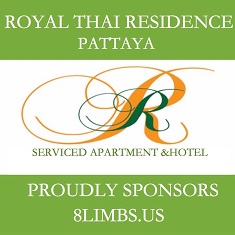Sabai
I focus fiercely on the pads strapped to each forearm of my trainer, Kru Den, as he calls out which strikes he wants me to throw into them. He calls for a kick and I rush to throw it, as if it’s a word-association game and I don’t want him to think I don’t understand the word. I feel on edge, like how a tennis player appears to be perched on her toes, ready to sprint in any direction. Of course, I feel the edginess of someone watching that sport, not what an actual, experienced tennis player really feels when they’re at the ready like that. Kru Den drops the pads down to his sides, his shoulders kind of slumping as their weight plumes down below his waist. “Sabai, sabai,” he says to me. Then, for good measure, he translates the word, “relax.” This happens within your first training session, it’s the primary correction that you’ll receive from any Thai padman, anywhere in the world, and I recall hearing it for years. I nod at Kru Den, I want him to know I acknowledge the correction and I am eager to accommodate it, but the truth is that behind my wordless gesture is a string of words inside my mind: how can I relax when I’m trying to hit things? Later on, I would get this correction during sparring, and in fights. How can I relax when someone is trying to hit me in the face?
Slowly (very slowly), I came to understand that the translation to “relax” is correct, but it’s incomplete. My own, Western, association with what that word means that makes it incompatable with training. To me, and many others, to relax is lying in a hammock, or sprawled on the couch in front of the TV, or anything that looks pretty passive in a single frame. It’s inert. It’s purposevely not doing in order to recharge, on a Sunday when you have no errands. That is all relaxing, yes. But to relax is not only passive; it is also a conscious transition from its opposite: relax your face, relax a muscle. It is to untense. The reason I have found it so difficult to arrive at this understanding of relax, in the context of training, is because the command – when not tied to a specific body part – doesn’t sound like a technical correction. “Turn your hip,” or “step on your kick,” those are immediately followable – at least in effort – because there is a directive toward an action. Relax, as a concept, is too all-encompassing. Were someone to have said to me, “untense,” I would probably have been able to identify exactly where I was so tense and ease up on it. Well, that part I have to take back already because it actually has taken me so long to be able to feel what my body is doing. Where is the tension? Or even better, when is the tension? Learning how to actually feel your body and the details of your body, while trying to execute technique, is the only way to become self-corrective. However, and here’s the tricky bit, you have to learn how to relax – or untense – in order to be able to feel anything beyond the stress of the effort itself.
When Kru Den tells me to kick, I can take a beat to find my balance, to push him back a bit, or to angle before I throw it. This isn’t being slow, it’s not as though I didn’t hear him or understand the command, I just took my time to execute a strong, relaxed kick. Now, padwork feels more like a conversation. Kru Den calling for the kick is like asking me for an example of a mammal, and instead of panicking and trying to answer as quickly as possible, so that he doesn’t think I don’t know what a mammal is or, god forbid, don’t have an example of one, the space between his asking and me answering now has consideration to it. I can pick my favorite mammal. Or I can pick an unusual one that wouldn’t be the first off the top of a 5-year-old’s head. I still answered the queston, it feels conversational.
Mua
I’m sitting on a straw mat, legs bent and knees tucked into my chest, watching the faces of children and families, illuminated by the soft glow of the lights around the ring. The sounds of a festival are everywhere, music and an announcer speaking too loudly into a microphone, so even someone a foot away from you requires concerted effort to hear. Therdkiat is standing in front of me, a beer can in his hand as he pantomimes a relaxed, Femeu movement between strikes. Then, like a fighting fish thrashing, he demonstrates how to throw some elbows before entering the clinch and then he tucks his head into his own elbows and starts kneeing the air furiously. These are my instructions for my fight, even though there are still hours to go before I climb into the ring. I nod and smile; he’s a bit drunk, but he’d be saying the exact same if he weren’t. Finally, he points his finger into the air, the classic scolding position, “mai mua, na!” My smile vanishes and I nod earnestly. This word, mua, is my trigger. It took years before I heard it, there were years when the only complaint was that I wasn’t sabai enough… and then came mai mua.
Mua means imprecice, confused, messy. Mai mua means not that, so Therdkiat is telling me not to brawl, more or less. Interestingly, this command is in the format that I wish sabai came in: don’t be tense, rather than relax. This is don’t be messy, rather than “look composed.” This word became such a trigger for me because I could not understand how not to be it, and was chastised repeatedly for being it. What the fuck does it mean? I couldn’t feel it; I had no idea what I was doing when I was scolded for it, so I didn’t know very well how to not be whatever that was. It might be like someone telling you not to be rude and you have to go over and over what you’ve just said, from every perceivable angle and interpretation, to figure out which part of it was rude. Was it your tone? The actual words? When you said it, or whom it was said to?
When I was filming with Ajarn Yai for the Muay Thai Library, I was hitting pads with one of his trainers, while Ajarn was calling out instructions. It was more or less improvised, he just yelled out commands of how to control space better, or when to angle. Specifically, the strikes were up to me. Many years ago, I’d been training with Sakmongkol, when I first moved to Pattaya, and he would tell me, “anything, anything, up to you.” Then, no matter what I threw, he would furrow his brow and say, “no.” I was lost. Anything, but not that. I felt this same confusion as Arjan Yai was giving me freedom to pick my strikes, but then micro-correcting nearly every movement. Finally, he stopped me, pushed me to the side and said, “mai mua.” Then, he recreated what I’d just done, but cleaner; simpler. Picture as an example, a young child recounting to you a story in which they keep getting lost in the details or side thoughts that pop into their head, so it takes 10 minutes to finish a story that is nearly impossible to follow. You look at your 12-year-old, who was with your younger kid when this happened and the older one summarizes in about 1 minute what the whole thing was, “we were late for the bus because Gus saw a neighbors dog got out of the gate; so we put the dog back inside the yard and the neighbor was grateful, so she drove us to the next stop and we got on.” The first one is mua. In the example of Sakmongkol telling me, “anything, up to you,” he’s saying, “tell me something you did today, anything, up to you.” And I will tell him something I did but if it is 4 things that have nothing to do with each other and they’re not explained in order or with any kind of coherence, he’ll go, “no.” When Arjan Yai told me mai mua and then showed me the cleaned up version, it was the absolute first time I really understood what mua meant, and thereby how not to be that. I was throwing too many strikes, rushing, crowding my own weapons and having no understanding of where my body was if I were to be countered somewhere in the middle of them. Music is playing any notes, but the way you arrange them is either discordant and atonal, or has a kind of natural progression and melody that sounds lovely. Scales exist for a reason.
So, when Therdkiat was telling me mai mua, I had already learned what that meant. I just had a lot of emotional baggage with how I felt about my own proximity and tendency toward mua. But really he’s just telling me not to rush, not to brawl, to go in there and, as my old Boxing coach in New York, Ray Valez, used to say, “act like you been here before.” Like, he wants me to go in and elbow and knee and absolutely destroy my opponent, but without screaming over myself and looking like I don’t know what I’m doing. If you’re going to go obliterate someone verbally, don’t do it with shouting and sounding like an angry drunk; be concise, pithy, smart and witty. A lot of what we see in Entertainment Muay Thai now is just mua. It’s exciting for people who don’t know what they’re looking at, in the same way that sword fights in movies can be fantastic if you don’t know that the technique is crap and the moves they’re doing only work because the prop swords weigh 1 pound. (I am one of these people, I don’t know sword types or what good swording looks like from bad swording; I just like when they make the ching ching, clang sounds.)
Tammachat
Kru Nu is holding for kicks and I’m slamming my shin into them, then more or less standing still until he angles his pads to indicate another strike. “Not like this,” he says to me, then offers the correction, “tammachat.” I’d heard this word once before, when Master K was talking to me in his basement in New Jersey, after a training session. I had no Thai back then and can’t even recall why he was using this word. I think he was talking about Buakaw, maybe, something about his style. The way Master K had translated it for me was “instinct.” As I squinted at Kru Nu, indicating my non-understanding, he started imitating what I was doing (a clumsy, tense, somewhat twitchy movement toward a kick), then transitioned to what he wanted (a smooth, calm, relaxed and flowing transition between waiting and striking). “Tammachat,” he said, to label the second one. After some more back and forth with concepts around the word itself, we arrive at “Natural.” I think this use is best understood by non-Thais with the phrase in English, “act natural, so nobody suspects.” Or maybe with athletes who seem to be “a natural” in their talent, or “make it look so effortless.”
Effortless is natural. A strained face, a tense body, the appearance of concerted effort is decidedly not “natural.” This one, again, is hard to accommodate because, quite frankly, nothing you’re doing in learning a new skill or artform is “natural.” You’re learning to move in ways your body doesn’t “naturally” move, and under pressure at that.
A while back I talked about this on a runcast, about my own two understandings of “natural.” I’m from Boulder, Colorado. When I was growing up, it didn’t take long to get outside of the city and be in what felt like “Nature,” for the sake of hiking, camping, exploring, or possibly dying in the mountains (depending on weather and preparedness). To me, as someone whose proximity to “open space,” was great, the idea of Nature is something untouched, like a reserve. But then I moved to New York for college and, while I was outside of the city, there seemed to be very little “nature” to be found. Not in the unkempt sense, as I knew it. But New York has Central Park and there were a few bike trails and playground areas near enough to my campus that I could go kind of feel like I was with Nature. Trees, flowers, squirrels. That’s nature. But it’s highly curated nature, the opposite of untouched, “preserved” nature. When thinking about the concept of tammachat, this dual meaning is interesting. Because the untouched version doesn’t work, because none of us just naturally moves like good Muay Thai and many times I hear people complain (and I’ve experienced this myself) that they’re “not naturally aggressive,” something they see as being a requirement for sparring or fighting. But then the curated version doesn’t work entirely either, because you can’t walk into Central Park or a Botanical Gardens, which are full of absolutely natural elements, and feel like your in a truly natural experience. The truth is, it’s somewhere between the two. In order for plants to grow properly, they need to be pruned. This is something that has blown the minds of me and Kevin as we’ve taken on a kind of half-hearted gardening role in our yard, but we’ve been delighted and fascinated by the parallels to learning an artform, where you have to cut and trim and restrain a little, in order to get blossoms and growth and health. Plants strangle other plants, or keep them from thriving, as they compete for space and sunlight and nutrients; Nature’s gardener is bees and birds and limited space. By trimming back some, you can create better balance. By leaving it all alone, it might be a beautifully overgrown mess for a while, but over time there is endless competition for survival in any given space. Muay Thai training is like this: you have to prune. And that’s also natural. Human beings interfering and gardening is quite natural. Animals eating one plant over another and creating a kind of balance in the competition, is also natural. So a person who is training in Muay Thai might appear mua by allowing everything they learn or see to have impact on their limited space and resources (their body and mind), and so some things will be strong and others will wither according to one’s “nature.” But a person who is training can also prune and assign space to certain elements over others, to appear more balanced and beautiful, without looking manicured or full of effort.
More recently I came upon a new understanding of tammachat that I found very exciting. It reminded me of what I’d slowly come to understand about mua (messy, confused, sloppy) and what that really means when my trainers are yelling at me for it. My realization was that it’s like speaking incoherently, using too many words or even combining concepts that don’t support one another and thereby sounding unintelligent or unfocused – this is the same as throwing strikes that don’t work together, crowding yourself, making a mess and basically causing your own movements to appear confused. So, in order to be mai mua or not mua, you need to carve away and allow your weapons and movements room to breathe; much like how tattoos last longer and are far more “readable” when there’s open skin within the design. My realization about tammachat came from trying to figure out how to say “spontaneous” in Thai. There’s no word for it, but rather you say “something that arises naturally.” Bringing this to Muay Thai, it is expressing the command toward tammachat to mean “unplanned,” or “unpredicted.” One of the more baffling qualities of Karuhat’s incredible Femeu style is how he can force you into a position or shape (making you predictable), which then gives him the opportunity to simplify the options you have to counter him if he’s going to punish you. If he has you blocking and on one leg, he’s now taken away half of your entire body and he only needs to decide between, maybe, two things you can do to counter him. Meanwhile, he has a much wider selection of moves at his disposal. That’s planning, but it’s like fooling a chess opponent into a position you know you can check them from. It is not planning your next three strikes, but rather laying out the trap to allow your opponent to walk into your trap. Imagine Sherlock Holmes setting someone up to confess to their whereabouts, such that he knows he has an airtight counter to their claim, which makes them unable to argue their innocence further. Then, the arrival of the counter appears so obvious, such a natural conclusion that nobody would argue an alternative. It looks so easy, so effortless. Imagine what an ass Holmes would appear if he were sweating, stuttering, and trying to bully the suspect into a confession (mua). Instead, we all seem to arrived at the obvious and inarguable conclusion quite spontaneously. There was planning, but none of it was perceivable nor memorized. That’s the kind of tammachat, natural performance of a yodmuay. You let your opponent expose their own weaknesses, as though it occurred naturally. The flower grew on this stem because you cut back the others; there are already taller plants in this side of the yard, so you place the shorter plants that need indirect sunlight under them, and so they thrive together.
My understandings of these concepts, these precepts, have been progressive. I understand sabai as a rung on the ladder to tammachat, but that they’re part of the same affect. Part of the difficulty, especially for Westerners, is that none of these corrections of sabai, mai mua, or tammachat are direct instruction, but rather attitudes or aspirations through which to shape every element of Muay. They’re the shears with which you prune the garden, the water with which you spray the plants, rather than a particular seed that you sew into the ground.






















